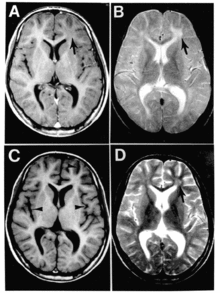| Subacute sclerosing panencephalitis | |
|---|---|
| Other names | Dawson disease |
 | |
| Subacute sclerosing panencephalitis. | |
| Specialty | Neurology, Infectious Disease |
| Symptoms | Behavior changes, seizures, spasticity, poor coordination, coma |
| Usual onset | 6-15 years after infection with measles |
| Causes | Measles virus |
| Risk factors | Measles infection |
| Diagnostic method | EEG, Serologic testing, brain biopsy |
| Prevention | Measles vaccine |
| Treatment | Supportive treatment |
| Medication | Intrathecal interferon alpha, intravenous ribavirin, isoprinosine |
| Prognosis | Usually fatal |
| Frequency | 2 in 10,000 for all age groups;[1] As high as 1 in 609 for unvaccinated infants under 15 months[2] |
Subacute sclerosing panencephalitis (SSPE), also known as Dawson disease, is a rare form of progressive brain inflammation caused by a persistent infection with the measles virus. The condition primarily affects children, teens, and young adults. It has been estimated that about 2 in 10,000 people who get measles will eventually develop SSPE.[1] However, a 2016 study estimated that the rate for unvaccinated infants under 15 months was as high as 1 in 609.[2][3] No cure for SSPE exists, and the condition is almost always fatal. SSPE should not be confused with acute disseminated encephalomyelitis, which can also be caused by the measles virus, but has a very different timing and course.[4]
SSPE is caused by the wild-type virus, not by vaccine strains.[5][6]
- ^ a b Bellini WJ, Rota JS, Lowe LE, Katz RS, Dyken PR, Zaki SR, Shieh WJ, Rota PA (2005). "Subacute sclerosing panencephalitis: more cases of this fatal disease are prevented by measles immunization than was previously recognized". The Journal of Infectious Diseases. 192 (10): 1686–1693. doi:10.1086/497169. PMID 16235165.
- ^ a b Wendorf, K, Winter, K, Harriman, K, Zipprich, J, Schechter, R, Hacker, J, Preas, C, Cherry JD, Glaser, C (2016). "Subacute Sclerosing Panencephalitis: The Devastating Measles Complication Is More Common Than We Think". Open Forum Infectious Diseases. 3. doi:10.1093/ofid/ofw194.81.
- ^ Sun, Lena (October 28, 2016). "New data shows a deadly measles complication is more common than thought". The Washington Post. Retrieved October 28, 2016.
- ^ Fisher DL, Defres S, Solomon T (2015). "Measles-induced encephalitis". QJM. 108 (3): 177–182. doi:10.1093/qjmed/hcu113. PMID 24865261.
- ^ Jafri, Sidra K; Kumar, Raman; Ibrahim, Shahnaz H (2018-06-26). "Subacute sclerosing panencephalitis – current perspectives". Pediatric Health, Medicine and Therapeutics. 9: 67–71. doi:10.2147/PHMT.S126293. ISSN 1179-9927. PMC 6027681. PMID 29985487.
- ^ Campbell, H; Andrews, N; Brown, K E; Miller, E (2007). "Review of the effect of measles vaccination on the epidemiology of SSPE". International Journal of Epidemiology. 36 (6): 1334–1348. doi:10.1093/ije/dym207. PMID 18037676.